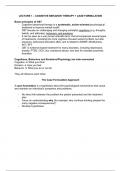Notizen
Lecture notes of all the 6 lectures of the CBT course
- Kurs
- Hochschule
This document contains notes on all the 6 lectures of the CBT course. Lectures were given by Elske Salemink, Katherine Meyerbroker, Anneke Verder & Franziska Lechner.
[ Mehr anzeigen ]



